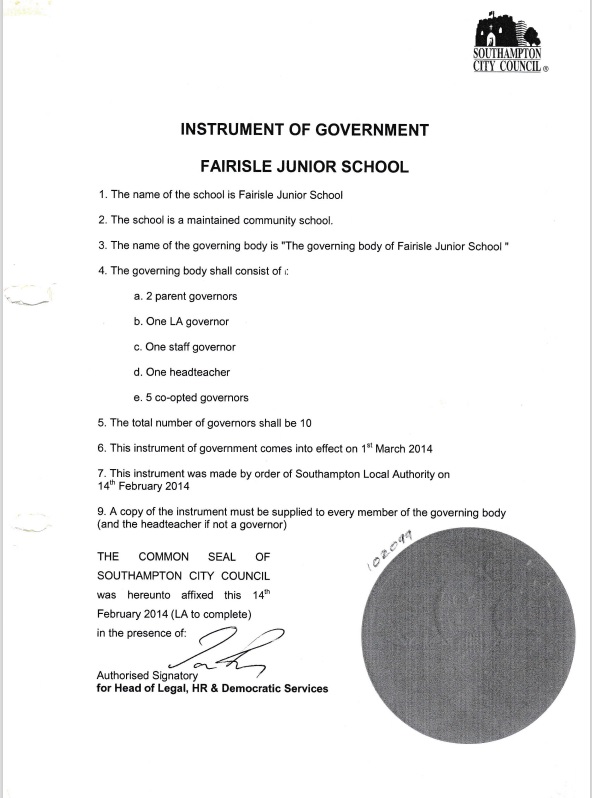The instrument of government sets out the constitution of a maintained school’s governing body. This means how many governors of each type sit on the governing body and the length of their terms of office if they are not the default four-year term.
It’s sometimes referred to as the instrument of governance, probably just because that sounds like a more natural name, but its correct title is the instrument of government. It’s also called the IoG for short.

Here’s an example of an instrument of government from a community school.

The information that the instrument must contain is set out in section 28 of the Constitution Regulations 2012. All instruments of government must contain the following information:
- the name and category of school, eg: Malory Towers, community school or Malory Towers, foundation school
- whether the school has a foundation and whether the school is a “qualifying” foundation school
- the name of the governing body, usually just “the governing body of Malory Towers Primary School”
- the number of governors of each type: parent, local authority, staff, headteacher, co-opted, foundation or partnership
- the total number of governors. There is no maximum number of governors, but the minimum number is seven
- the term of office of any category of governor, if less than four years. The minimum term of office for any governor is one year
- whether the term of office for any governor of a particular category may be determined by those appointing that governor
- for foundation schools, the name of anyone who can appoint governors (and the basis on which appointments are made if more than person can appoint)
- for foundation schools, details of any ex officio governors (governors whose role comes with their office, such as parish priest) and who can remove these governors
- for foundation and voluntary schools with a religious character, a description of the religious ethos of the school
- for federated schools, the names and categories of each federated school and for faith schools in a federation “a single description of the religious ethos of each such school”
- the date the instrument of government takes effect.
Headteachers can choose not to take up their place on the governing body (officially they would need to resign as a governor) but they can also choose to withdraw their resignation at any time, so a place must always be available for them.
All maintained schools must have places for the headteacher, one staff governor only, one local authority governor only and as many co-opted governors as are considered “necessary”. A separate article explains more about the different types of governor.
Schools that are not joined together in a federation, ie: all single schools, must also have at least two parent governors.
All federated schools must have places for each headteacher from the federation and only two parent governors. (The requirement for two parent governors comes from a 2016 amendment; note that the original 2012 law required one parent from each federated school.)
Foundation and voluntary-aided schools must also comply with additional laws which depend on your specific type of school. They are set out in section 14 of the Constitution Regulations 2012 (or section 22 of the Federation Regulations 2012 if your school is part of a federation).
A copy of the instrument must be given to every governor and the headteacher, whether or not the head is a governor.
Are associate members listed in the instrument?
No, associate members do not appear in the instrument of government. There is no limit to the number of associate members a board can appoint and you can increase or reduce the number of associate members without changing the instrument.
Where can I find the instrument of government?
The clerk to governors should have a copy. If the clerk can’t find one the chair, vice-chair or headteacher may have a copy. If no-one at the school can locate a copy the governor services department of the local authority will be able to provide one.
Does the instrument of government need to be reviewed annually?
No, there’s no need for governors to review or approve the instrument annually. However, it is sensible to review it occasionally, perhaps every few years, to consider whether you have the ideal number of governors of each type for your current circumstances.
Must the instrument of government be on the school website?
No, there’s no requirement to publish the actual instrument itself, but you do need to publish information about governance including the names of all governors and who appointed them. A separate article covers what needs to be published online.
How do we amend the instrument of government?
The instrument of government can be amended at any time to add or remove governors or change the number of governors in a category. Because this means changing the constitution of the board this process is known as reconstitution.
If you wish to reconstitute governors should give their approval to change the instrument of government at a full governing body meeting. Schools with foundation governors will also need the approval of those governors, trustees of any foundation and their local diocese or other linked religious body.
“In the case of a school with foundation governors, the governing body must not submit a revised draft unless it has been approved by the foundation governors; the trustees of any foundation relating to the school; the appropriate diocesan authority; and in the case of any other school designated as having a religious character, the appropriate religious body.”
Constitution of Governing Bodies of Maintained Schools: Statutory Guidance
If two or more schools are forming a federation, where one governing body oversees multiple schools, the governing bodies that are merging prepare a draft instrument jointly.
The clerk should then submit the new draft instrument to the local authority, together with the minutes of the meeting when the amendments were approved. The LA will approve the changes if they conform with the law.
One tip is to choose an even number of governor positions in your constitution because this makes it slightly easier to be quorate, for which you need 50% of governors (excluding vacancies).
For example, if you have ten governors on the board the quorum is five, but if you have nine governors the quorum is still five because figures must be rounded up.
Remember that in many cases applicants will qualify for more than one governor type, so if you have no parent governor vacancies and an eager parent wishes to join the board they can fill a co-opted vacancy, for example.
Model Instrument of Government
A model instrument, which can be adapted to fit any kind of maintained school, can be found in annex C of the DfE’s statutory guidance to the constitution regulations.
